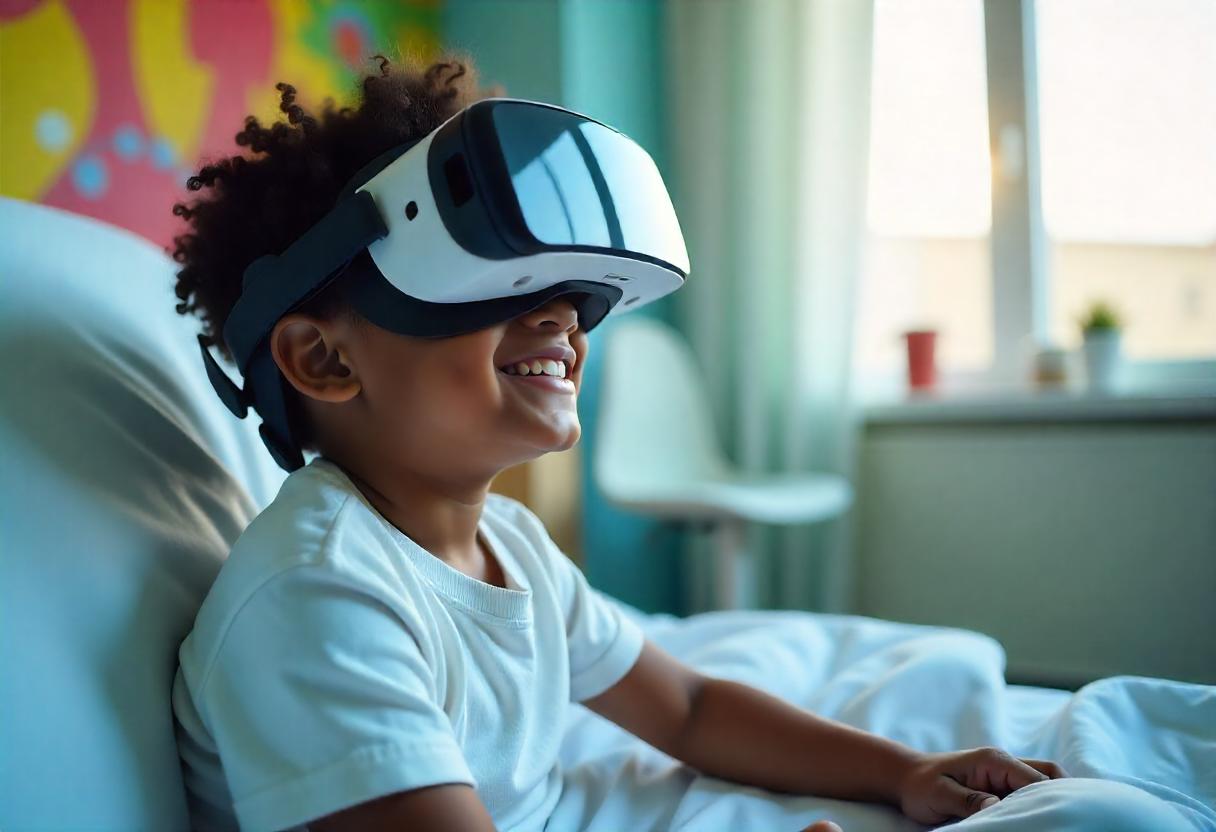Introduction: A New Prescription for Pain
In a treatment room at Lucile Packard Children’s Hospital Stanford, a young boy named Blaine Baxter prepares for a painful dressing change. But instead of bracing for discomfort, he slips on a virtual reality headset and is transported into a calming underwater world. As dolphins swim past and coral reefs shimmer, Blaine’s anxiety fades. The procedure begins—and he barely notices.
This is the promise of Virtual Reality (VR) distraction therapy, a rapidly emerging tool in pediatric healthcare. Designed to reduce pain and anxiety during medical procedures, VR is proving to be more than a novelty. It’s a clinically validated, non-pharmacological intervention that’s reshaping how children’s hospitals deliver care—and how they source the hardware to do it.
The Evidence: VR’s Clinical Impact on Pediatric Patients
A growing body of research supports VR’s effectiveness in pediatric settings. A 2022 mixed-methods study published in Frontiers in Digital Health evaluated the Relaxation-VR prototype in children aged 4–16. The results were compelling: VR significantly reduced pain, anxiety, and stress, while increasing happiness and cooperation during procedures.
A systematic review and meta-analysis published in Pediatric Anesthesia in 2022 analyzed 26 studies and found that VR distraction therapy led to a statistically significant reduction in both pain (standardized mean difference = –0.67) and anxiety (–0.74) compared to standard care.
These findings are echoed in real-world applications. At Leeds Children’s Hospital in the UK, a 2022 report by the Starlight Children’s Foundation found that 91% of children who used VR during treatment said it made the experience better, and 87% reported feeling little or no pain.
Case Study: Blaine Baxter and Stanford’s VR Program
Lucile Packard Children’s Hospital Stanford was among the first in the U.S. to implement VR therapy across all pediatric units. Blaine Baxter, who suffered a traumatic arm injury in a go-kart accident, became a poster child for the program. Traditional distractions failed to ease his distress during dressing changes. But with VR, his pain perception dropped dramatically. “It was like he wasn’t even in the room,” his mother told Stanford Medicine News.
This anecdote is backed by broader institutional success. Stanford’s program has expanded to include VR for preoperative anxiety, chemotherapy sessions, and even physical therapy.
The Hardware Behind the Healing
Implementing VR in a hospital setting requires more than just headsets. Pediatric hospitals must source hardware that meets strict criteria:
- Sanitization: Devices must be easy to disinfect between uses.
- Durability: Equipment must withstand frequent handling by children.
- Ease of Use: Systems should be intuitive for both staff and patients.
- Content Customization: Experiences must be age-appropriate and medically relevant.
Vendors like KindVR and Rendever offer hospital-grade VR kits that include wireless headsets, disposable face pads, and HIPAA-compliant software. These systems are designed specifically for clinical environments, with preloaded therapeutic content and remote support options.
Bulk Sourcing: A New Frontier in Hospital Procurement
As VR becomes standard in pediatric care, hospitals are shifting from pilot programs to full-scale deployments. This transition demands a new approach to procurement—one that emphasizes:
- Volume Discounts: For outfitting multiple departments or entire facilities.
- Custom Kits: Tailored to specific clinical needs (e.g., oncology, radiology).
- Lifecycle Support: Including software updates, training, and maintenance.
- Regulatory Compliance: Ensuring devices meet local and international standards.
Platforms like SourcingGuides.com are uniquely positioned to facilitate this shift. By connecting hospitals with vetted suppliers, they streamline the sourcing process and ensure quality control.
However, challenges persist. The VR hardware market is fragmented, with varying levels of quality and support. Rapid technological change also means that today’s devices may be outdated within a few years. Procurement officers must balance innovation with sustainability.
Economic and Operational Benefits
Beyond clinical outcomes, VR therapy offers tangible operational advantages. The Starlight VR Distraction Therapy Report noted that procedures were completed more efficiently, with fewer sedation requirements and higher patient cooperation. These efficiencies translate into cost savings and improved throughput.
Moreover, VR can enhance patient satisfaction scores—a key metric in value-based care models. Hospitals that adopt VR not only improve outcomes but also boost their reputational capital, attracting top talent and philanthropic support.
Looking Ahead: The Future of VR in Pediatric Care
The next frontier for VR in children’s hospitals includes:
- Biometric Integration: Real-time monitoring of heart rate and stress to personalize experiences.
- AI-Driven Content: Adaptive environments that respond to a child’s emotional state.
- Tele-VR: Remote specialists guiding patients through procedures via avatars.
As these innovations emerge, the need for scalable, interoperable hardware solutions will grow. Hospitals that invest in flexible procurement strategies today will be better equipped to adapt tomorrow.
Conclusion: Healing Through Innovation
VR distraction therapy is more than a technological trend—it’s a paradigm shift in pediatric care. By transforming how children experience pain and anxiety, VR is not only improving clinical outcomes but also redefining the procurement landscape for children’s hospitals.
For B2B stakeholders, this is a moment of opportunity. The demand for VR hardware is rising, and those who can deliver reliable, scalable, and child-friendly solutions will be at the forefront of a digital health revolution.
As Blaine Baxter’s story reminds us, sometimes the best medicine isn’t a pill—it’s a portal to another world.









